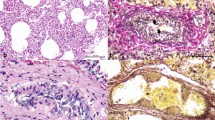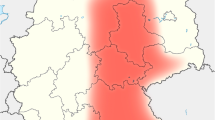Abstract
RECENTLY it has been shown1 that a virus isolated from cattle with signs of ‘mucosal disease’2 is antigenically related to the virus of bovine virus diarrhœa3. In northern Sweden, a type of mucosal disease (‘Umeå disease’) was found to be accompanied or preceded by a respiratory disease. In paired serum samples from diseased animals increasing titres of antibodies were demonstrated against both bovine virus diarrhœa virus and para-influenza 3 virus4, but only para-influenza 3 virus was isolated5. The incidence of infections with bovine virus diarrhœa virus among Swedish cattle seems to be about 20 per cent as judged from the results of a serological survey in 1959–604. In the present work the properties on which Cooper6 bases his classification of animal viruses have been investigated for bovine virus diarrhœa virus.
This is a preview of subscription content, access via your institution
Access options
Subscribe to this journal
Receive 51 print issues and online access
$199.00 per year
only $3.90 per issue
Buy this article
- Purchase on Springer Link
- Instant access to full article PDF
Prices may be subject to local taxes which are calculated during checkout
Similar content being viewed by others
References
Gillespie, J. H., Coggins, L., Thompson, J., and Baker, J. A., Cornell Vet., 51, 155 (1961).
Ramsey, F. K., and Chivers, W. H., North Amer. Vet., 34, 629 (1953).
Olafson, P., MacCallum, A. D., and Fox, F. H., Cornell Vet., 36, 205 (1946).
Dinter, Z., and Bakos, K., Bull. Off. Internat. Epiz., 56, 29 (1961).
Bakos, K., and Dinter, Z., Nature, 185, 549 (1960).
Cooper, P. D., Nature, 190, 302 (1961).
Gillespie, J. H., Baker, J. A., and McEntee, K., Cornell Vet., 50, 73 (1960).
Schwerdt, C. E., Proc. Fourth Intern. Cong. Biochem., Vienna, 1958, 7, 130 (Pergamon Press, Ltd., London, 1959).
Albertsson, P.-Å., Partition of Cell Particles and Macromolecules (Almqvist and Wiksell, Uppsala, 1960).
Andrewes, C. H., and Horstmann, D. M., J. Gen. Microbiol., 3, 290 (1949).
Pyl, G., Exp. Vet. Med., 5, 1 (1951).
Herrmann, Jun., E. C., Proc. Soc. Exp. Biol. Med., 107, 142 (1961).
Salzman, N. P., Virology, 10, 150 (1960).
Smith, J. D., Freeman, G., Vogt, M., and Dulbecco, R., Virology, 12, 185 (1960).
Dinter, Z., Arch. Exp. Vet. Med., 15, 218 (1961).
Sheffy, B. E., Coggins, L., and Baker, J. A., cited by Gillespie et al., (ref. 1).
Darbyshire, J. H., Vet. Rec., 72, 331 (1960).
Huck, R. A., Vet. Rec., 69, 1207 (1957).
Author information
Authors and Affiliations
Rights and permissions
About this article
Cite this article
HERMODSSON, S., DINTER, Z. Properties of Bovine Virus Diarrhœa Virus. Nature 194, 893–894 (1962). https://doi.org/10.1038/194893a0
Issue Date:
DOI: https://doi.org/10.1038/194893a0
This article is cited by
-
Viral protein production in homogeneous and mixed infections of cytopathic and noncytopathic BVD virus
Archives of Virology (1990)
-
Electron microscopic studies of bovine viral diarrhea virus in tissues of diseased calves and in cell cultures
Archives of Virology (1982)
-
Virus-like particles in bovine turbinate cells infected with bovine virus diarrhoea/mucosal disease virus
Archives of Virology (1981)
-
Cell culture adaptation and propagation of a reovirus-like agent of calf diarrhea from a field outbreak in nebraska
Archiv f�r die gesamte Virusforschung (1972)
-
Bovine virus diarrhoea virus: Inhibition of growth by proflavine sulphate
Archiv f�r die gesamte Virusforschung (1971)
Comments
By submitting a comment you agree to abide by our Terms and Community Guidelines. If you find something abusive or that does not comply with our terms or guidelines please flag it as inappropriate.



